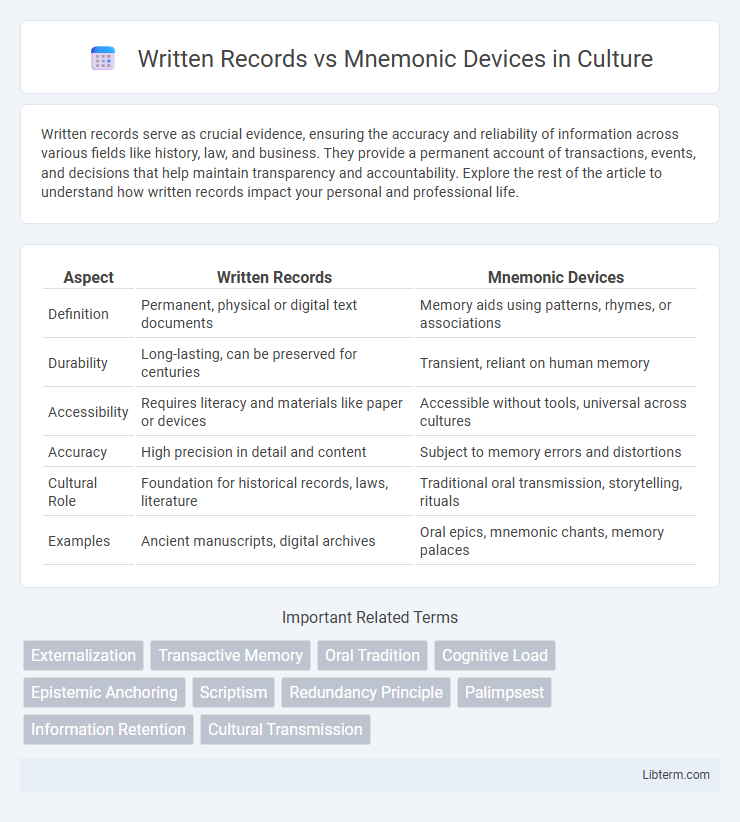Written records serve as crucial evidence, ensuring the accuracy and reliability of information across various fields like history, law, and business. They provide a permanent account of transactions, events, and decisions that help maintain transparency and accountability. Explore the rest of the article to understand how written records impact your personal and professional life.
Table of Comparison
| Aspect | Written Records | Mnemonic Devices |
|---|---|---|
| Definition | Permanent, physical or digital text documents | Memory aids using patterns, rhymes, or associations |
| Durability | Long-lasting, can be preserved for centuries | Transient, reliant on human memory |
| Accessibility | Requires literacy and materials like paper or devices | Accessible without tools, universal across cultures |
| Accuracy | High precision in detail and content | Subject to memory errors and distortions |
| Cultural Role | Foundation for historical records, laws, literature | Traditional oral transmission, storytelling, rituals |
| Examples | Ancient manuscripts, digital archives | Oral epics, mnemonic chants, memory palaces |
Introduction to Written Records and Mnemonic Devices
Written records preserve information through physical or digital documentation, enabling accurate and permanent storage of data over time. Mnemonic devices enhance memory by using patterns, acronyms, or associations to facilitate recall without external tools. Both methods serve distinct cognitive and archival purposes, with written records providing external reliability and mnemonics supporting internal memory retention.
Historical Overview of Information Preservation
Ancient civilizations prioritized written records, such as cuneiform tablets in Mesopotamia and hieroglyphics in Egypt, to preserve laws, trade transactions, and religious texts with lasting accuracy. Mnemonic devices, including oral traditions and memory palaces, were vital in cultures like Ancient Greece and Indigenous communities, enabling the transmission of epic poetry, genealogies, and oral histories across generations without physical documentation. The evolution from mnemonic methods to systematic writing systems marked a pivotal shift in information preservation, enhancing reliability and accessibility of knowledge over time.
Defining Written Records: Types and Examples
Written records encompass various forms of documented information including manuscripts, ledgers, official reports, and digital files that serve as tangible evidence of transactions or events. Examples of written records are historical manuscripts like the Dead Sea Scrolls, financial documents such as balance sheets, archival government records, and digital databases used in contemporary data management. These diverse types of written records ensure accurate preservation, organization, and retrieval of critical data for legal, academic, and administrative purposes.
Understanding Mnemonic Devices: Methods and Usage
Mnemonic devices enhance memory retention by linking new information to familiar patterns, such as acronyms, visual imagery, and rhymes, facilitating faster recall compared to written records alone. Techniques like the method of loci and chunking organize data spatially or categorically, optimizing cognitive processing and retrieval efficiency. These devices are especially effective in learning environments where active engagement with material strengthens neural connections beyond passive note-taking.
Cognitive Impact: Memory Retention vs External Storage
Written records serve as external storage systems that reduce cognitive load by allowing individuals to offload information, enhancing long-term memory retention through repeated review and reference. Mnemonic devices improve internal memory retention by creating meaningful associations, patterns, or visual imagery that facilitate encoding and recall without relying on external aids. The cognitive impact of written records emphasizes durability and accessibility, whereas mnemonic devices optimize mental encoding and retrieval efficiency.
Accuracy and Reliability of Written vs Mnemonic Recall
Written records provide superior accuracy and reliability compared to mnemonic devices due to their ability to capture exact details without distortion over time. Mnemonic devices rely on individual memory, which is prone to errors, omissions, and subjective interpretation, reducing their effectiveness for precise information retention. In contexts requiring consistent data retrieval, written documentation remains the most dependable method for preserving factual accuracy.
Accessibility and Efficiency in Knowledge Retrieval
Written records provide universal accessibility and long-term storage, enabling efficient retrieval through indexing and search tools that transcend memory limitations. Mnemonic devices enhance personal memory by creating associations, but their effectiveness depends on individual cognitive abilities and are less practical for managing extensive or complex information. Combining written records with mnemonic strategies optimizes knowledge retrieval by balancing systematic data organization with personalized recall techniques.
Evolution of Practices in Modern Education
Written records provide a tangible, permanent method of information storage crucial for modern education's data management and curriculum design. Mnemonic devices enhance student memory retention by leveraging cognitive psychology principles, boosting learning efficiency and exam performance. The evolution from purely oral traditions to integrated written and mnemonic techniques reflects advancements in educational technology and pedagogical strategies aimed at optimizing knowledge acquisition.
Advantages and Limitations of Each Method
Written records offer precise, permanent documentation ideal for complex data storage and long-term retrieval but require literacy and can be susceptible to physical damage or loss. Mnemonic devices enhance memory retention and quick recall through mental associations, benefiting learners and oral cultures, yet they may oversimplify information and lack detailed context. Balancing these methods depends on the need for accuracy versus ease of memorization, with written records excelling in durability and mnemonics in cognitive accessibility.
Integrating Written Records and Mnemonics for Optimal Learning
Integrating written records with mnemonic devices enhances memory retention by combining visual, contextual, and sensory cues with structured documentation. Written notes provide detailed, organized information while mnemonics aid quick recall through patterns, acronyms, and imagery. Using both methods creates a synergistic learning approach, improving comprehension and long-term retention across various educational contexts.
Written Records Infographic

 libterm.com
libterm.com